Thermal Behaviors of 1-Amino-2-nitroguanidine
2016-05-08LIYanfengWANGMengjieXUKangzhenSONGJirongZHAOFengqi
LI Yan-feng, WANG Meng-jie, XU Kang-zhen, SONG Ji-rong, ZHAO Feng-qi
(1. School of Chemical Engineering, Northwest University, Xi′an 710069, China; 2. Xi′an Modern Chemistry Research Institute, Xi′an 710065, China)
1 Introduction
Guanidine compounds are a kind of important nitrogen-rich energetic materials, and have evolved into an extremely wide-ranging field of application. Various high-nitrogen-content energetic salts including full series of amination products of the guanidinium cation (amino-, diamino-, triamino-guanidinium and nitroguanidine cation) have been investigated[1-3]. As a known guanidine derivative containing both an amine and a nitro substituent, 1-Amino-2-nitroguanidine (ANQ) is also an important concerned object for its good detonation properties[4]. ANQ was first synthesized in 1920 s[5-7], while it was not considered as energetic material at that time. In recent years, Klapötke T M started to research the potential properties of ANQ as energetic material, and found that ANQ is a promising energetic compound to replace RDX[8-10]. The density, detonation velocity and detonation pressure of ANQ are 1.767 g·cm-3, 8977 m·s-1and 32.3 GPa, respectively[8], which are close to that of RDX and better than guanidine and its derivatives, but its sensibility and production cost are lower than those of RDX.
It is predicted that the ANQ-based energetic salts may have po
tentially broad application in the fields of explosives. For example, ANQ can be used as an intermediate for the synthesis of 5-nitriminotetrazole[11]and bis-nitraminotriazoles[12]. In addition, Klapötke reported a series of derivatives of ANQ, including halides (Cl-, Br-and I-) of ANQ[13], some transition metal complexes[14], and other energetic salts[4]. 1-Amino-2-nitroguanidinium nitrate (ANGN) was synthesized by Jin X H[15], and it has been found that ANGN possesses excellent energetic properties compared to those of RDX and HMX. Moreover, other ionic energetic materials of ANQ have been also developed recently[16-19]. Unfortunately, for a majority of these derivatives of ANQ, their decomposition temperatures are much lower than that ANQ, which is a great shortage for these derivatives.
In this paper,we mainly reported the thermal behavior, specific heat capacity and adiabatic time-to-explosion of ANQ for further estimating its thermal stability.
2 Experimental
2.1 Synthesis
ANQ was prepared according to reference[20] and recrystallized in hot water.13C NMR (DMSO-d6, 800 MHz): 162;1H NMR (DMSO-d6, 800 MHz): 9.32, 8.27, 7.55, 4.67; IR (KBr,ν/cm-1): 3357, 3280, 1667, 1615, 1579, 1515, 1497, 1410, 1261, 1146, 846, 745, 687. Anal.Calcd. for CH5N5O2(%): C 10.09, H 4.23, N 58.81; Found: C 10.22, H 4.32, N 58.78.
2.2 Physical Measurements
Differential scanning calorimetry (DSC) experiments were performed using a DSC200F3 apparatus (Germany, NETZSCH). The heating rates were 2.5, 5.0, 7.5, 10.0 ℃·min-1from ambient temperature to 300 ℃, respectively. The thermogravimetry/differential thermogravimetry (TG/DTG) experiment was performed using a SDT-Q600 apparatus (TA, USA). The heating rate used was 5.0 ℃·min-1from ambient temperature to 400 ℃. The specific heat capacity (cp) was determined using a Micro-DSCIII apparatus (SETARAM, France), and the sample mass was 215.00 mg. The heating rate was 0.2 K·min-1from 10 ℃ to 80 ℃.
3 Results and Discussion
3.1 Thermal Decomposition Behavior
Typical DSC in Fig.1 indicates that the thermal behavior of ANQ presents two coterminous intense exothermic decomposition processes. The two decompositions occur in a narrow range of temperature from 185 ℃ to 205 ℃ at the heating rate of 5 ℃·min-1. The extrapolated onset temperatures and peak temperatures of the two decomposition processes are 191.4 ℃ and 192.7 ℃ for the first, and 196.1 ℃ and 196.2 ℃ for the second, respectively. The whole decomposition enthalpy is -2075 J·g-1. TG/DTG curves at the heating rate of 5 ℃·min-1in Fig.2 also indicate the two decomposition processes are overlapped, but there is obvious transition at 195.21 ℃. The two exothermic decompositions are very intense, and can produce certain jet power to make thermobalance shake up and down. Meanwhile, the two decompositions are very complete, and there is almost no residuum in crucible (0.06%) at 300 ℃. Moreover, we also can find that the thermal decomposition process of ANQ becomes more and more intense with the rise of heating rate, even the tumble of common Al crucible can be found at the heating rate of 10 ℃·min-1, DSC curve changes up and down as shown in Fig.3. The decomposition of ANQ presents a distinguishing feature of temperature-high and process-intense.
The apparent activation energy (E) and pre-exponential constant (A) of the first exothermic decomposition process for ANQ was obtained by a multiple heating method (Kissinger method[21]and Ozawa method[22]). DSC curves are shown in Fig.4. The determined values of the beginning temperature (T0), extrapolated onset temperature (Te) and peak temperature (Tp) at the different heating rates are listed in Table 1. The values ofT00andTe0corresponding toβ→0 obtained by Eq.(1) are 167.7 and 184.5 ℃[23].
(1)
wherenandmare coefficients.
From the calculated values ofEand lgAin Table 1,Eobtained by Kissinger method agrees well with that by Ozawa method, and the linear correlation coefficients (r) are close to 1. So the result is credible. Moreover,Eof the process was low, indicating that ANQ easily decompose above 180 ℃.
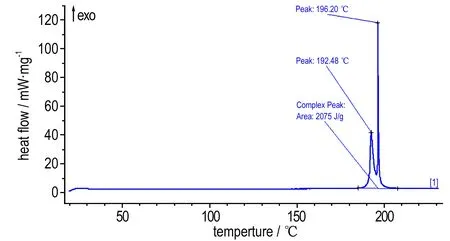
Fig.1 DSC curve of ANQ at 5 ℃·min-1
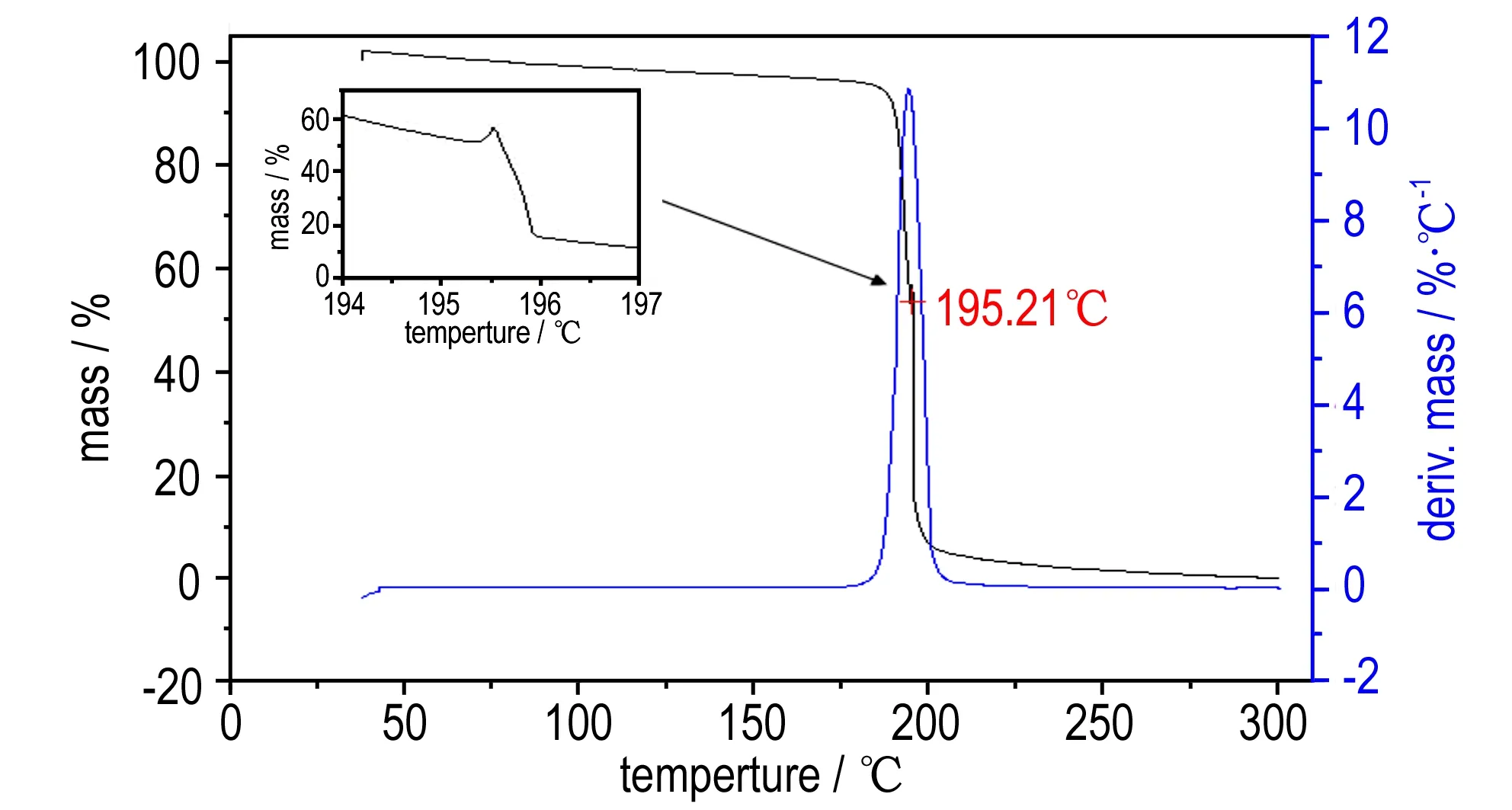
Fig.2 TG/DTG curves of ANQ at 5 ℃·min-1
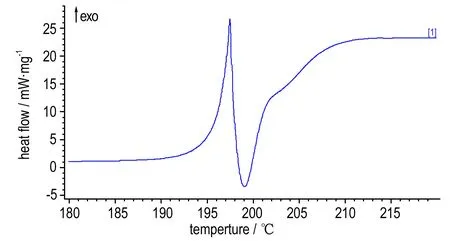
Fig.3 DSC curve of ANQ at 10 ℃·min-1
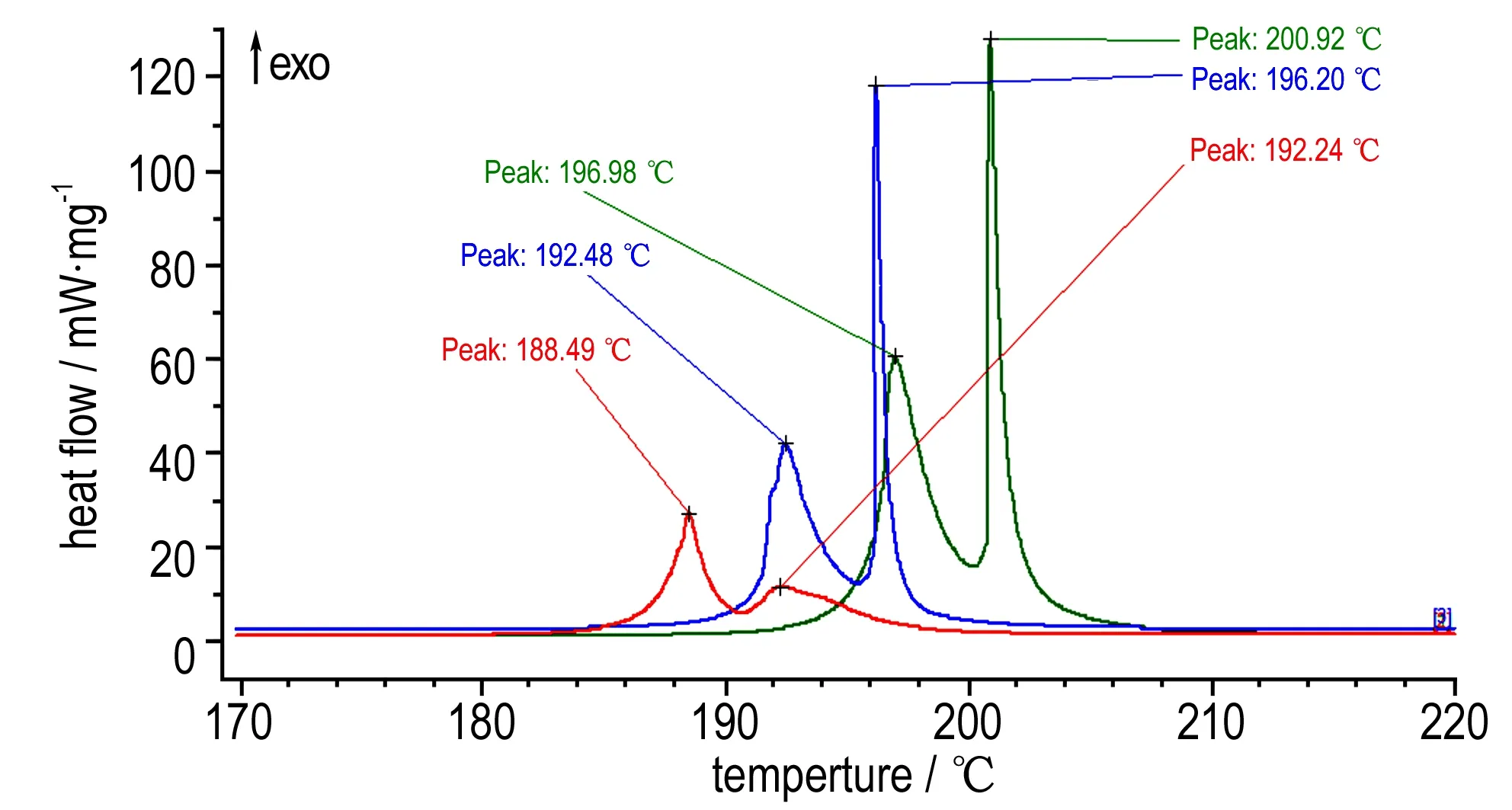
Fig.4 DSC curves of ANQ at different heat rates
Table 1 The values ofT0,Te,Tpand kinetic parameters of the first decomposition process for ANQ

β/℃·min-1T0/℃Te/℃Tp/℃EK/kJ·mol-1lg(A/s-1)rKEO/kJ·mol-1rO2.5176.9187.6188.55.0183.7191.5192.57.5188.1196.2197.0224.323.150.983220.60.984
Note: Subscript K, data obtained by Kissinger method; subscript O, data obtained by Ozawa method.
The self-accelerating decomposition temperature (TSADT) and critical temperature of thermal explosion (Tb) are two important parameters required to ensure safe storage and process operations for energetic materials and then to evaluate the thermal stability.TSADTandTbcan be obtained by Eqs.(2) and (3)[23-24].TSADTandTbfor ANQ are 184.5 ℃ and 192.7 ℃, respectively, indicating that the thermal stability of ANQ is high.
TSADT=Te0
(2)
(3)
The entropy of activation (ΔS≠), enthalpy of activation (ΔH≠) and free energy of activation (ΔG≠) of the thermal decomposition process for ANQ corresponding toT=Tp0=458.15 K,A=AK=1023.15s-1andE=EK=224.3 kJ·mol-1can be calculated as 186.38 J·mol-1·K-1, 220.49 kJ·mol-1and 135.10 kJ·mol-1 [25], respectively. 194.7 J·mol-1·K-1, 224.3 kJ·mol-1and 135.1 kJ·mol-1 [25], respectively.
3.2 Specific Heat Capacity
Fig.5 shows the determination result ofcpfor ANQ, using a continuous specific heat capacity mode of apparatus.cppresents a good linear relationship with temperature in determined temperature range. Specific heat capacity equation is shown as:
cp(J·g-1·K-1)=0.3632+2.8810×10-3T
(283.0 K (4) wherecpis the specific heat capacity in J·g-1·K-1 The specific heat capacity and molar heat capacity of ANQ are 1.222 J·g-1·K-1and 145.5 J·mol-1·K-1at 298.15 K, respectively. Fig.5 Determination results of the continuous specific heat capacity for ANQ The adiabatic time-to-explosion is also an important parameter for evaluating the thermal stability of energetic materials and can be calculated by Eqs.(5), (6) and (7)[23, 25-28]. (5) (6) (7) Wherecpis the specific heat capacity, J·mol-1·K-1;Tis the absolute temperature, K;tis the adiabatic time-to-explosion, s;Qis the exothermic values, J·mol-1;Ais the pre-exponential factor, s-1;Eis the apparent activation energy of the thermal decomposition reaction, J·mol-1;Ris the gas constant, J·mol-1·K-1;f(α) is the most probable kinetic model function;αis the conversion degree and the limit of temperature integration is fromT00toTb. In fact,the conversion degree (α) of energetic materials from the beginning decomposition to explosion in the adiabatic condition is very small, and it is very difficult to obtain the most probable kinetic model functionf(α). So, we separately used Power-low model, Reaction-order model, Avrami-Erofeev model and the above obtained kinetic model function to estimate the adiabatic time-to-explosion and supposed different rate orders (n)[23, 29]. The calculation results are listed in Table 2. Table 2 The calculation results of adiabatic time-to-explosion modelrateorderequationtime/spower-lowmodeln=1f(α)=115.2n=2f(α)=2α1/253.6n=3f(α)=3α2/368.6n=4f(α)=4α3/471.2reaction-ordermodeln=0f(α)=115.2n=1f(α)=1-α15.5n=2f(α)=(1-α)215.8avrami-ero-feevmodeln=1f(α)=1-α15.5n=2f(α)=2(1-α)[-ln1-α()]1/254.4n=3f(α)=3(1-α)[-ln1-α()]2/369.5n=4f(α)=4(1-α)[-ln1-α()]3/472.1 The calculated result indicates that there are some deviations, and the decomposition model has big influence on the estimate of adiabatic time-to-explosion. From the whole estimated result, the adiabatic time-to-explosion of ANQ should be about 60 s. Though the decomposition of ANQ is very intense, certain time of heat accumulation from the beginning decomposition to thermal explosion is necessary, which can be certified by DSC curve of low heating rate. The time also indicates that ANQ has good thermal stability. (1) The thermal behavior of ANQ can be divided into two coterminous intense exothermic decomposition processes. The peak temperatures of the two decomposition processes at the heating rate of 5 ℃·min-1are 192.5 and 196.2 ℃, and the whole decomposition enthalpy is -2075 J·g-1. The self-accelerating decomposition temperature and critical temperature of thermal explosion are 184.5 ℃and 192.7 ℃, respectively. (2) Specific heat capacity equation of ANQ iscp(J·g-1·K-1)=0.3628+2.8810×10-3T(283.0 K [1] Wang R, Xu H, Shreeve J M, et al. Bis[3-(5-nitroimino-1,2,4-triazolate)]-based energetic salts: Synthesis and promising properties of a new family of high-density insensitive materials[J].JournaloftheAmericanChemicalSociety, 2010, 132: 11904-11905. [2] Huang Y G, Zhang Y Q, Shreeve J M. Nitrogen-rich salts based on energetic nitroaminodiazido[1, 3, 5]triazine and guanazine[J].Chemistry-AEuropeanJournal, 2011, 17: 1538-1546. [3] Jin X H, Hu B C, Liu Z L. Synthesis and properties of two energetic salts based on 1-amino-2-nitroguanidine[J].JournaloftheBrazilianChemicalSociety, 2015, 26: 124-130. [4] Fischer N, Klapötke T M, Stierstorfer J. 1-Amino-3-nitroguanidine (ANQ) in high-performance ionic energetic materials[J].ZeitschriftfürNaturforschungB, 2012, 67: 573-588. [5] Phillips R, Williams J F. Nitro-aminoguanidine[J].JournaloftheAmericanChemicalSociety, 1928, 5: 2465-2470. [6] Henry R A, Makosky R C, Smith G B L. Preparation of nitroaminoguanidine[J].JournaloftheAmericanChemicalSociety, 1951, 73: 474. [7] McKay A F. Nitroguanidines[J].ChemicalReview, 1952, 51: 301-346. [8] Klapötke T M, Stierstorfer J. Current advances in RDX replacements[C]∥Proceedings of the 27thArmy Science conference. Orlando, FL, USA, 2010, November 29-December 2. [9] Klapötke T M, Stierstorfer J. Potential replacements of RDX with low sensivities[C]∥Insensitive Munitions Energetic Materials Technology Symposium. Munchen Marriott Hotel Munich, Germany, 2010, October 11-October 14. [10] Zhang G Q, Liu X B,Huang M. Review on energetic nitroguanidine derivatives[J].ChineseJournalofEnergeticMaterials(HannengCailiao), 2013, 21(5): 668-674. [11] O′Connor T E, Fleming G, Reilly J. Diazotization of nitroaminoguanidine[J].JournaloftheSocietyofChemicalIndustry, 1949, 68: 309-310. [12] Metelkina E L, Novikova T A, Berdonosova S N,et al. 2-Nitroguanidine derivatives: IX. Reaction of 1-amino-2-nitroguanidine with oxalic acid as a method of synthesis of 3(5)-nitroamino-1,2,4-triazole-5(3)-carboxylic acid and 5,5'-bi(3-nitroamino-1,2,4-triazole) salts[J].RussianJournalofOrganicChemistry, 2005, 41: 440-443. [13] Fischer N, Klapötke T M, Lux K, et al. Inorganic amino-nitro-guanidinium derivatives[J].Crystals, 2012(2): 675-689 [14] Fischer N, Joas M, Klapötke T M, et al. Transition metal complexes of 3-amino-1-nitroguanidine as laser ignitible primary explosives: Structures and Properties[J].InorganicChemistry, 2013, 52: 13791-13802. [15] Jin X H, Hu B C, Liu Z L,et al. Structure and properties of 1-amino-2-nitroguanidinium nitrate[J].RSCAdvance, 2014(4): 23898-23903. [16] Whitemore W F, Revukas A J. Nitroguanylhydrazones of some common aldehydes and ketone[J].JournaloftheAmericanChemicalSociety, 1935, 57: 706-708. [17] Lieber E, Sherman E, Henry R A, et al. The reaction of nitrous acid with nitroaminoguanidine[J].JournaloftheAmericanChemicalSociety, 1951, 73: 2327-2329. [18] Gao H X, Shreeve J M. Azole-based energetic salts[J].ChemicalReview, 2011, 111: 7377-7436. [19] Wu B, Yang H W, Tang Y X,et al. New energetic derivatives of 1-amino-3-nitroguanidine[J].JournalofEnergeticMaterials, 2015, 33: 180-190 [20] Castillo-Meléndez J A, Golding B T. Optimization of the synthesis of guanidine from amines via nitroguanidines using 3,5-dimethyl-N-nitro-1H-pyrazole-1-carboxamidine[J].Synthesis, 2010, 10: 1655-1663. [21] Kissinger H E. Reaction kinetics in differential thermal analysis[J].AnalyticalChemistry, 1957, 29: 1702-1706. [22] Ozawa T. A method of analyzing thermogravimetric data[J].BulletinoftheChemicalSocietyofJapan, 1965, 38: 1881-1886. [23] Hu R Z, Gao S L, Zhao F Q, et al. Thermal Analysis Kinetics (2th)[M]. Beijing: Science Press, 2008. [24] Zhang T L, Hu R Z, Xie Y, et al. The estimation of critical temperatures of thermal explosion for energetic materials using non-isothermal DSC[J].ThermochimicaActa, 1994, 244: 171-176. [25] Xu K Z, Chen Y S, Wang M, et al. Synthesis and thermal behavior of 4,5-dihydroxyl-2-(dinitromethylene)-imidazolidine (DDNI)[J].JournalofThermalAnalysisandCalorimetry, 2011, 105: 293-300. [26] Smith L C. An approximate solution of the adiabatic explosion problem[J].ThermochimicaActa, 1975, 13: 1-6. [27] Xu K Z, Song J R, Zhao F Q, et al. Thermal behavior, specific heat capacity and adiabatic time-to-explosion of G(FOX-7)[J].JournalofHazardousMaterials, 2008, 158: 333-339. [28] Xu K Z, Qiu Q Q, Ma H X, et al. Thermal properties of 1-amino-1-hydrazino-2,2-dinitroethylene cesium salt[J].JournalofEnergeticMaterials, 2013, 31: 273-286. [29] Vyzovkin S, Burnham A K, Criado J M, et al. ICTKA kinetics committee recommendations for performing kinetic computations on thermal analysis data[J].ThermochimicaActa, 2011, 520: 1-19.
3.3 Adiabatic Time-to-explosion
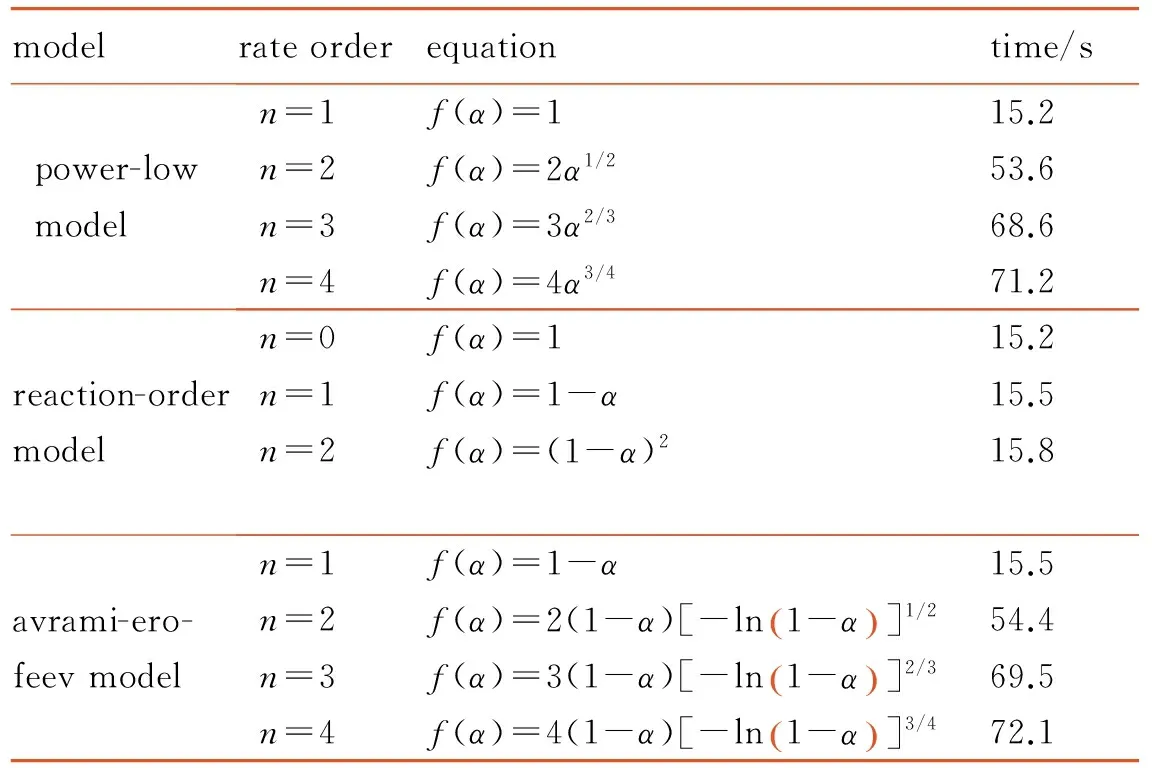
4 Conclusions
杂志排行
含能材料的其它文章
- Crystal Structure and Thermal Behavior of Potassium Dinitromethane
- Coatings of Activated Metal Hydride and Application in the Fuel-rich Propellant
- Synthesis and Properties of 5-(3-Amino-1,2,5-oxadiazol-4-yl)tetrazol-1-ol and Its Ammonium and Hydroxylammonium Salts
- The Tensile Properties and Creep Performance of a Long-term Thermally Aged Plastic Bonded Explosive
- Energies of Combustion and Specific Heat Capacities of Diaminofurazan, Dinitrofurazan and Diaminoazofurazan
- Synthesis and Thermal Properties of 1,1′-Dioxide-5,5′-azotetrazole Dipotassium Salt
